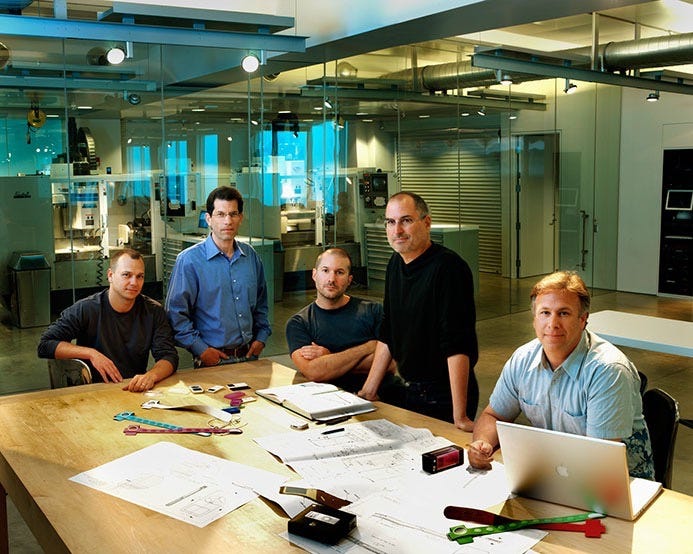Product Study: iPhone
One of a handful of product case studies I wrote last year to help understand successful product launches.
Apple's iPhone was announced December 9, 2007 and released June 29, 2007. It was $499 for the 4GB version, $599 for 8GB. After 8 years it had captured 50% of U.S. smartphone market and >66% of sales, with 100 million users. (1) Value created -- Simply describe the innovation. How did it create value? The iPhone is a pocket computer. It has typical phone capabilities including phone calls and text messaging, along with cellular internet connectivity. Differences between other smartphones at the time were:
Large multi-touch screen with no tactile keyboard, no need for stylus -- this allowed full use of screen when not using keyboard
Ability to browse normal, non WAP, websites (can zoom easily using multi-touch)
Ability to run desktop-class applications
Multiple sensor inputs -- proximity, light, accelerometer
(2) Value captured — Competitive advantages, barriers to entry. Why didn't incumbents have a reason to fight them?
Distribution:
Extension from existing Apple network -- iTunes, Mac OS, iPod.
Brand attachment to Apple.
Economies of scale exist with integration and complexity of engineering.
Switching costs once owning an iPhone.
Strong habit attached to usage many times / day -- strong attachment to UX.
Phone makers saw it as toy for rich people at first. Computer makers didn't see it as a computer (low-end disruption).
(3) Job-to-be-done — What jobs does the innovation fulfill?
iPhone itself does the job of providing a computing device (with UI & sensory input) to access the internet and other applications. "When I'm on the go, I want to have access to a computer, so I can have fun and be more productive."
Substitutes: other smartphones, laptop computers, PDAs, doing nothing, countless other devices individual apps eventually replaced.
(4) Technology
Where in the "stack" does it fit in? (Why then?) Built on existing cellular network. Individual hardware components already existed but had never been put in such a small package together: CPU chip, sensors, LCD screen. Multi-tough tech just barely becoming cheap & small enough.
Any unique technical abilities/insights that enabled it? Many on the hardware side.
How difficult was it to develop? Highly difficult given form-factor capability packed in small structure. Original iPhone took 1,000+ people 2.5 years and $150 million to develop.
(5) Design
What major needs does it fulfill? The device . . .
Can fit in a pocket (or small purse).
Doesn't need to be plugged in constantly.
Can do all the things a "normal" cellphone can do. (So users don't have to carry both.)
Has internet access.
Has enough compute power to perform top ~20% of computer tasks.
Has an interface where users can easily access all this information.
How did design affect product outcome?
Hardware design intention was to make device very simple -- only 2 primary buttons (Home & Sleep/wake) and 3 secondary (volume up, down, silent).
Software UI design was extremely important as there was a lot of information that had to be accessed & manipulated on such a small device. If things are hard to retrieve people won't use it.
New multi-touch UI / gesture control very important -- Matched core mental models about how the world works (rubber-banding, pinch zoom, swipe, etc.) in a way that made use very intuitive.
These traits led to high usability and widespread adoption.
(6) Most important metrics
Usability -- Time to first X, # Clicks to X (X = photo, browser visit, email, SMS, etc.)
Engagement -- how often average user opened/used device
Gross profit per device including carrier subsidies
(7) Distribution
Innovation: What about the innovation made it amenable to distribution?
Solved a problem very well + signaled high social status (expensive but not TOO much)
Highly visible/observable to people around users
Compatibility -- software was compatible with existing infrastructure. Form (with new UI) not compatible with existing *phone* mental models, but it was with other models (see "design" above)
Low complexity
Communication channels: How did people find out about it?
Traditional marketing -- simple, effective marketing campaigns
Strong word-of-mouth
Apple Stores -- ability to play with & experience
Delivery (supply chain): How was the innovation physically delivered to users?
Direct-to-consumer, including web and Apple Store sales
Mobile providers (Cingular/AT&T at first)
Timeline:
Launched June 2007
Next 3 years to 2011: Innovators / early adopters (~16%)
Next 2-3 years to 2013-14: Early majority (30-40%)
Next 2-3 years to 2015-16: Late majority (30-40%)
Remaining laggards: 2016 forward…
Approximate new iPhone users per year in U.S.:
(8) Management -- What personal aspects led to success/failure?
Did any 1 (or more) people play a significant role in outcome? Steve Jobs led the vision and Jony Ive the design. Without either the iPhone would not have had the success it did. Many others were pivotal but these 2 were key.
What skillsets/talents were needed in development & distribution?
Ability to see the whole picture (design, technical, marketing)
No "lead by committee" -- strong guidance and focus from the top
Lots of moving parts & critical aspects, so project management & organization critical
Strong sense of design and intuition about what customers want
(9) What were the 1-3 things that ultimately made it a success/failure?
Design of the device (hardware and software).
Strong marketing & product vision led by Steve Jobs.




